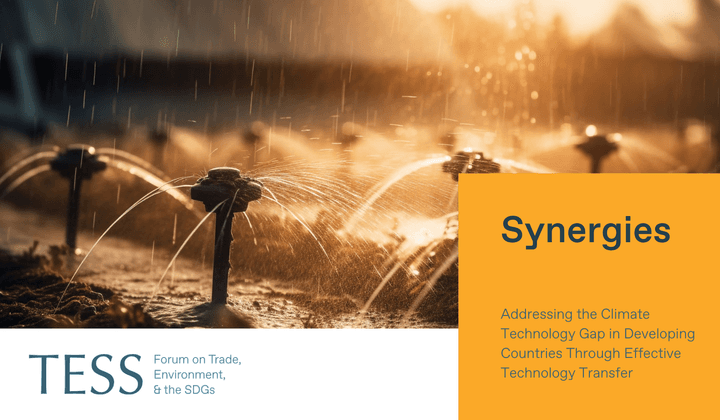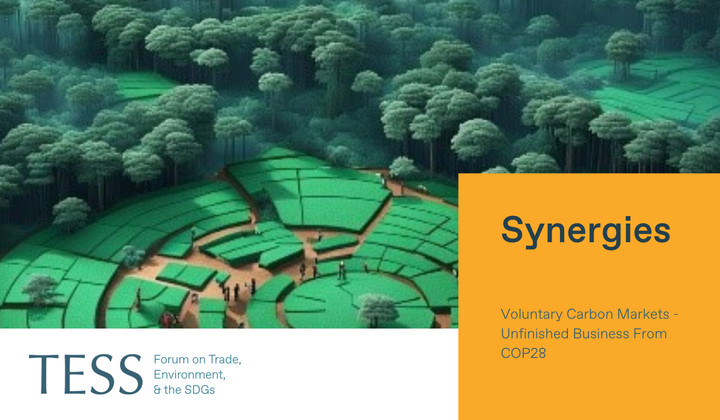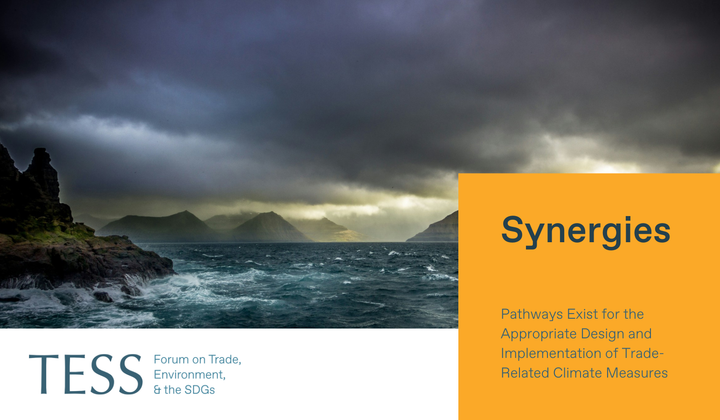Emerging and developing economies, with the exception of China, remain at the fringes of low-carbon technology trade. Future deals under Article 6 of the Paris Agreement could include the transfer of climate technologies directly from home to host country, either at prevailing market prices or at deeply discounted or below market rates, in exchange for carbon credits. To avoid potential friction in such trade in climate technologies, there are avenues for cooperation within the World Trade Organization and beyond.
This article is part of a Synergies series on reviving multilateralism curated by TESS titled From Vision to Action on Trade and Sustainability at the WTO. Any views and opinions expressed are those of the author(s) and do not necessarily reflect those of TESS or any of its partner organizations or funders.
-----
Climate technologies are booming. 2023 saw a one-year jump of more than 50 percent in global renewable capacity. Expect continued rapid growth in the coming years.
Climate technologies fall into two big buckets. The first, and by far the largest, comprises mitigation or low-carbon technologies critical to meet decarbonization goals and net zero targets. Such technologies include a widening basket of renewable energy goods and services, as well as energy efficiency and others. The second basket comprises goods and services that support climate adaptation; examples include information and communication technologies vital for early warning systems, water irrigation technologies, climate-resilient crops, expertise needed for green, resilient infrastructure, water-bombers to fight wildfires, and many others.
Wonderful Lists
Climate technologies are changing. Familiar technologies like solar and wind are expanding at scales not seen before. Innovation is creating wholly new product categories, from net-zero steel to real-time carbon emission monitoring sensors.
The great Italian writer Umberto Eco once wrote that nothing is “more wonderful than a list.” Unfortunately, no internationally agreed list of climate technologies exists.
The IMF’s recent list is therefore welcome in consolidating and expanding previous low-carbon technology lists, adding for example new categories like rechargeable batteries.
And the Problems They Show
The list confirms two big problems in international efforts to promote the spread of climate technologies.
The first problem: climate adaptation technologies are barely mentioned. Aside from a few goods like energy-efficient air conditioners, refrigeration, and heat pumps—included because of their comparatively lower carbon footprints rather than their cooling functions—the list is dominated by mitigation-related technologies like solar panels, wind turbines, electric vehicles, and others. These comprise the bulk of the estimated $1.7 trillion clean technology global market.
The second problem is what the list reveals. Emerging and developing economies, with the exception of China, remain at the fringes of low-carbon technology trade. The leading five exporters of low-carbon technologies are China, Germany, the United States, Japan, and Korea, and the top five importers are the United States, China, Germany, the United Kingdom, and France.
Promises to Keep
This wasn’t the deal in the 1992 United Nations Framework Convention on Climate Change (UNFCCC) agreement, which pledged in Article 4 to “cooperate in the full, open and prompt exchange of relevant scientific, technological, technical, socio-economic and legal information.”
Such optimism seemed reasonable at the time, given other successes. Agreement on the Montreal Protocol in 1987 was soon followed by the launch of its Multilateral Fund in 1989, created to help developing countries access additional finances for green technologies that avoided ozone-depleting substances. To date, over $5 billion in grants have been disbursed, making the Montreal Protocol both the most successful international environmental agreement as well as the gold standard in international efforts to promote technology transfer.
By contrast, the UNFCCC has struggled from the outset in financing and technology transfer. The 2015 Paris Agreement tried to inject a new urgency to the issue, pledging to realize “technology development and transfer in order to improve resilience to climate change and to reduce greenhouse gas emissions.” Various working groups were established before and after Paris: the UNFCCC Technology Mechanism, the Climate Technology Centre & Network (CTCN), and various specialized UN programmes. Yet the trade data makes clear that such efforts are falling short.
Early Paris Technology Deals
Another provision of the Paris Agreement offers a glimmer of hope. The objective of Article 6 is to enable cooperation through international public sector carbon markets. A handful of actual deals have begun. A Switzerland-Thailand agreement under Article 6.2 entails Switzerland financing the conversion of buses from internal combustion engines to electricity. Another involves Swiss financing of solar panels in Vanuatu. So far, these deals resemble thousands of other clean energy overseas development assistance projects, but for an important twist.
What’s new is the link between technology investments and carbon credits. In exchange for its investments in low-carbon technologies, Switzerland is eligible to receive international carbon credits—called internationally transferred mitigation outcomes (ITMOs)—roughly matching the avoided greenhouse gas emissions enabled by these technologies.
Another Swiss bilateral agreement with Ghana involves climate-smart rice production, which may support the much needed bundling of mitigation and adaptation deals (although any carbon credits would be limited to the mitigation outcome).
In turn, Switzerland can apply these credits to its Nationally Determined Contribution and net zero mid-century targets.
These early Article 6.2 deals entail the financing of domestic technologies and capacities rather than trade or transfer. But future Article 6 deals could include the transfer of climate technologies directly from home to host country, either at prevailing market prices or at deeply discounted or below market rates, in exchange for carbon credits. With nearly 200 Article 6 deals in a project pipeline dominated by industrial energy efficiency and renewable energy technologies, a clearer picture will emerge in the coming months.
With nearly 200 Article 6 deals in a project pipeline dominated by industrial energy efficiency and renewable energy technologies, a clearer picture will emerge in the coming months.
Unfortunately, this is one among several areas where the climate and trade regimes might clash. What if, for example, China, Japan, or other clean energy powerhouses transferred technologies directly to developing economies at below market rates? The whole point of Article 6.8 of the Paris Agreement is precisely to advance non-market deals, but it is unclear what World Trade Organization (WTO) rules allow. Such lingering uncertainty discourages positive action on the climate front.
It is no secret that trade in climate technologies is a source of friction from tariffs on solar panels to early steps covering a booming trade in electric vehicles. Article 6 deals could exacerbate such tensions, drawing claims of export subsidies, dumping, injury, or other concerns.
Supporting Cooperation
Some steps could avoid potential friction.
A first is to bolster information sharing between the UNFCCC and WTO. For example, governments engaged in Article 6 deals that include clean technologies should notify various WTO bodies such as the Working Group on Trade and Transfer of Technology, the Trade and Environmental Sustainability Structured Discussions (TESSD), or via Article 66.2 of the WTO’s Agreement on Trade-Related Aspects of Intellectual Property Rights (TRIPS Agreement).
Joint discussions could also include sharing technology-related assessments and related guidance underway as part of the rule-making of the Paris Agreement Article 6.4 Supervisory Body. Recent draft assessments have included cautionary opinions regarding nascent technologies like carbon capture and storage. More definitive guidelines are expected from that Subsidiary Body by the 2024 UN Climate Change Conference (COP29) in November.
Information exchanges could draw lessons from the Montreal Protocol, including the proposed implementation of the 2023 decision regarding energy efficiency standards for refrigeration, air conditioning, and heat pumps, all of which will have significant avoided emissions effects covering stratospheric ozone and climate goals
Information exchanges could draw lessons from the Montreal Protocol, including the proposed implementation of the 2023 decision regarding energy efficiency standards for refrigeration, air conditioning, and heat pumps, all of which will have significant avoided emissions effects covering stratospheric ozone and climate goals.
A second step is to update on an ongoing basis a list of low-carbon and adaptation-related technologies. The 2023 IMF list is a good start.
Clearly, an updated list could support more ambitious goals, notably reducing tariffs and taking other steps to facilitate trade in climate-friendly goods and services. Decades of stalled WTO discussions intended to define a list of environmental goods and services seems likely to continue. Nonetheless, an updated list would support other goals, not least tracking trade in emerging product categories like net-zero aluminum or new generations of high-efficiency goods.
With a few exceptions, technology transfer has been widely endorsed and rarely implemented. Now is the time to make overdue climate technology transfer deals work at scale, with the proactive support of the trade regime
-----
Brad McDonald is a Lecturer with the University of Minnesota, Humphrey School of Public Affairs, and former Deputy Head of Trade, IMF.
Scott Vaughan has worked for the secretariats of UNEP, the WTO, and the NAFTA Environment Commission.
The authors are grateful for the helpful comments from TESS colleagues and an anonymous reviewer.
-----
Synergies by TESS is a blog dedicated to promoting inclusive policy dialogue at the intersection of trade, environment, and sustainable development, drawing on perspectives from a range of experts from around the globe. The editor is Fabrice Lehmann.
Disclaimer
Any views and opinions expressed on Synergies are those of the author(s) and do not necessarily reflect those of TESS or any of its partner organizations or funders.
License
All of the content on Synergies is licensed under a Creative Commons Attribution-NonCommercial-ShareAlike 4.0 International (CC BY-NC-SA 4.0)
license. This means you are welcome to adapt, copy, and share it on your platforms with attribution to the source and author(s), but not for commercial purposes. You must also share it under the same CC BY-NC-SA 4.0 license.
If you would like to reuse any material published here or if you have any other question related to Synergies, send an email to fabrice.lehmann@graduateinstitute.ch.



